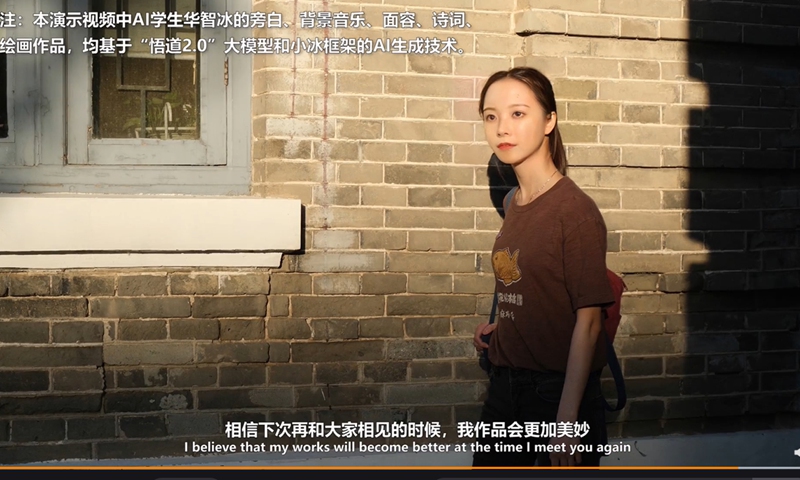清华AI学生华智冰首次露正脸唱歌:会弹吉他、歌声甜美
9/29/2021
今年6月份,清华大学计算机系知识工程实验室正式公布了中国首个原创虚拟学生——华智冰,师从智源研究院学术副院长、清华大学教授唐杰,并由北京智源人工智能研究院、智谱AI和小冰联合培养。
近日,团队首次发布了她的正面露脸视频,视频里的她歌声甜美,表情动作也十分真实。她的歌声、人类生物学特征全部由人工智能完成,肢体则有团队成员进行训练完成。
Sep 28, 2021
对此,不少网友都表示简直不敢相信,甚至直呼“华智冰女神 YYDS”。
但需要注意的是,从目前已知信息来看,这段视频中其实只有面部表情和声音是华智冰的部分,其余的肢体动作等都是由团队成员@鱼子酱酱 来完成,整段视频时通过该作者的原始视频处理而来。
即便如此,华智冰的完成度依然令人赞叹,其面部表情非常的真实自然,歌声同样非常顺畅,只是声音中还保留了一些电子化效果,听起来有些像是电音,未来通过不断学习、进化,有望达到媲美真人的效果。
另外,据此前官方介绍,华智冰的智商和情商双高,可以作诗、作画、创作剧本杀,还具有一定的推理和情感交互的能力,其背后的奥妙是一个“智能数字脑”,数字大脑通过大规模认知预训练模型来完成数据与知识的驱动。

Source
Jun 3, 2021
华智冰,是基于“悟道2.0”诞生的中国原创虚拟学生,脸部、声音都通过人工智能模型生成。具有丰富知识、与人类有良好交互能力的机器人,会创作的音乐、诗词和绘画作品。2021年6月1日,“华智冰”在北京正式亮相并进入清华大学计算机科学与技术系知识工程实验室学习。
First virtual student ‘enrolls’ at Tsinghua University
By Cheng Yu
6/05/2021
Hua Zhibing, China’s first virtual student enabled by the country’s largest pre-trained model, made its debut on Tuesday.
With the move, Hua officially became a student in the Department of Computer Science and Technology at Tsinghua University in Beijing.
Hua, a “woman”, is able to compose poetry and music and has some ability in reasoning and emotional interaction.
The virtual student was co-developed by the Beijing Academy of Artificial Intelligence, Zhipu AI and a company, Xiaoice. It is powered by the second generation of WuDao, a pre-trained model.
“Compared with other common pre-trained models like GPT-3, WuDao is a multimodal model, which can understand and generate pictures and other content formats,” said Tang Jie, deputy dean of academic affairs at the academy and a Tsinghua University professor.
GPT-3 is English-centered, while WuDao is multilingual, including in both English and Chinese. In the future, more languages will be added, Tang said.
“WuDao is also more open than GPT-3 and many other pre-trained models. The training data, programming codes and model APIs are all open to the public,” he added.
Tang pointed out that the potential of such models is huge, as many real scenarios can use the same model with more general large pre-trained models.
“The key significance of WuDao is that it lowers the application threshold of AI and reduces the cost of the training process of machine learning models, including labor costs and carbon emissions,” he said.
Source: https://global.chinadaily.com.cn/a/202106/01/WS60b5f5d8a31024ad0bac2dc5.html
China’s first virtual student developed by Tsinghua U meets fans on Weibo
By Global Times
6/05/2021

China’s first virtual student developed by Tsinghua University met fans on Thursday as she opened an account on China’s Twitter-like Sina Weibo platform.
In the first Weibo post, the female virtual student named Hua Zhibing, greeted Chinese netizens and said that she will start studying in the computer laboratory in Tsinghua University.
Hua Zhibing attracted close to 2,000 followers on Weibo in about nine hours.
A video introducing Hua Zhibing was published in her first Weibo post. In it, a young girl wanders around the campus while a female voice introduces herself.
“I’ve been addicted to literature and art since I was born. The scientists not only gave me my appearance and my voice but also taught me to compose,” Hua Zhibing said, noting said the background music in the video was composed by her.
The girl in the video was a real person but the face and voice were virtually synthesized, Tang Jie, a professor at the Department of Computer Science of Tsinghua University, one of the major developers of Hua Zhibing, said during a forum on artificial intelligence held between Tuesday and Thursday in Beijing.
Hua Zhibing officially registered and became a student of Tsinghua University on Tuesday. Developers said at the forum that they have high expectations for Hua Zhibing, hoping she can keep learning, exploring and cultivating the abilities of creativity and communication in the future. She might also be employed after graduating from the university, developers said.
Hua Zhibing was based on the latest version of a China-developed deep learning model, Wudao 2.0, which literally means “understanding of natural laws.” It can process 1.75 trillion parameters, breaking the record of 1.6 trillion previously set by Google’s Switch Transformer AI language model.
The appearance of Hua Zhibing soon became a hot topic on Weibo.
Some are amazed by how China has advanced in the field of artificial intelligence. Some netizens said they were curious whether scientists would create a humanoid robot named Hua Zhibing, rather than a virtual face and voice.
Some joked that if more robots like Hua Zhibing, which can learn and work, are created in the future, population decline would not be a problem in the world.
Source: https://www.globaltimes.cn/page/202106/1225392.shtml


